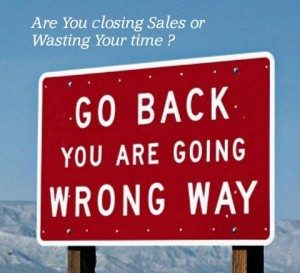Selling intangibles (and a lot of tangibles or just trying to get your point across) requires that you connect the dots for most customers because in many instances they won’t. They simply hear what your product does and it is the rare person who will make the leap to applying it to their particular situation The current podcast episode explains closing and shows you how to do it like a pro.
During a workshop one of the participants stated she could not get past buyers saying they could do what she sold themselves. My response to her was “did you ask, but would you?’ She was startled because she had not thought of asking that question. This said to me that she had not established value and simply told the customer what her product did and not why they needed to use her product as an alternative.
I like to mention the “not sold in stores” commercials because cheesy or not they follow a time tested approach that works. It is a standard model of defining the problem with short vignettes and then proceeding with another short vignette showing how their product solves the problem for you. Very little is left to chance that you might not understand what their product does for you. Next they set a price, usually 19.99, and once again tell you what the product will do for you. Then you hear the famous “but we’re not stopping there” and they say order 2 and you get both for that same 19.99, which is really $10 dollars each (and probably the real price). The commercial finally ends with a time window for you to order which creates a sense of urgency to make that call or go online because supplies are limited.
Closing (the art of asking for the order) is a skill that goes beyond simply telling the person what your product does. It involves storytelling to help the customer understand what is in it for them, and if done skillfully the buyer does not realize they are being closed and actually understands why your product is something they need.
One skillful way to draw in the customer, going back to that person who said they could do the task themselves, is the future close: “If I show you how you save three hours by using my  widget, what would you do with the extra time?” That simple question plants the idea in the customer’s mind first that you have something that can save them time, and second it moves the customer into the future where they are picturing themselves enjoying all that extra time your widget will give them. Next, follow that up with another closing statement of “And isn’t that what you really want to happen, being able to take advantage of the extra time you gain using this widget?” Then restate your key benefits (doing this is important because it can take a minimum of three times before what you’ve said really registers with a person) and once again close with “Let’s get you signed up so you can start taking advantage of that extra time as soon as possible?”. The customer now has a clear idea of what the advantage is for them to give you their hard earned money, rather than simply knowing what your product does.
widget, what would you do with the extra time?” That simple question plants the idea in the customer’s mind first that you have something that can save them time, and second it moves the customer into the future where they are picturing themselves enjoying all that extra time your widget will give them. Next, follow that up with another closing statement of “And isn’t that what you really want to happen, being able to take advantage of the extra time you gain using this widget?” Then restate your key benefits (doing this is important because it can take a minimum of three times before what you’ve said really registers with a person) and once again close with “Let’s get you signed up so you can start taking advantage of that extra time as soon as possible?”. The customer now has a clear idea of what the advantage is for them to give you their hard earned money, rather than simply knowing what your product does.
Another approach using that same customer is the comparison close: Ask them how long they thought it would take to complete the task and all the steps that would be involved in getting there. You literally take them step by step in comparing the simple task they had in their head with the reality involved in doing it, and contrast that with what your product does. That is the advantage of the comparison close which is part of what you are seeing in those cheesy commercials. They are asking you to compare all the work involved in the way you currently do something with what their product will do.
There are many other types of closes that will help you in a very conversational manner connect the dots for the customer to help them make a decision. So stop wasting your time simply describing your product and start closing your prospect at every opportunity.
If you like the show, be sure to subscribe on iTunes and Stitcher. If you really like it, be sure to write a review. It helps the show.

